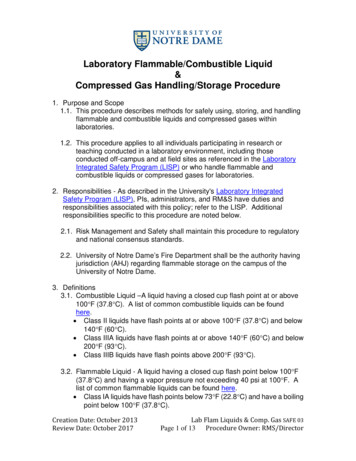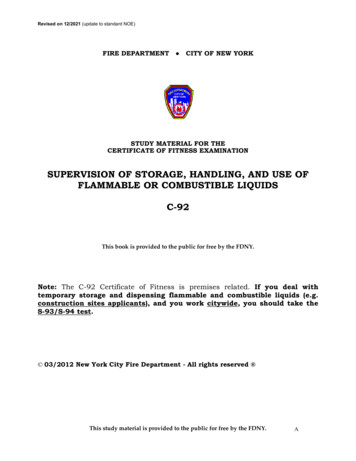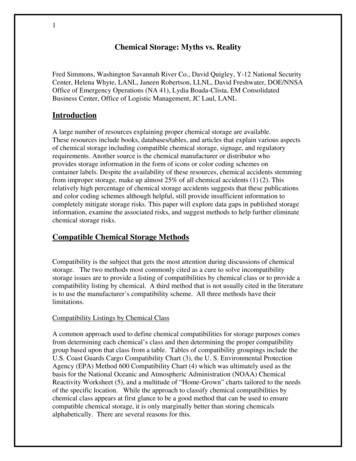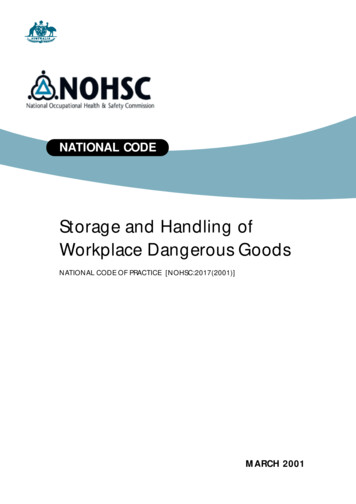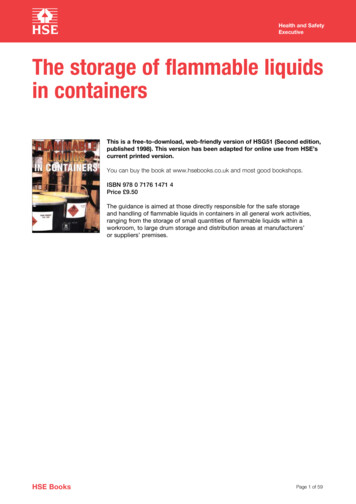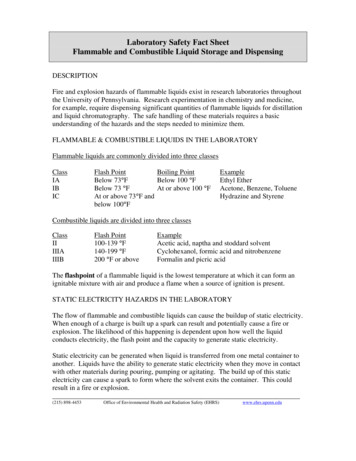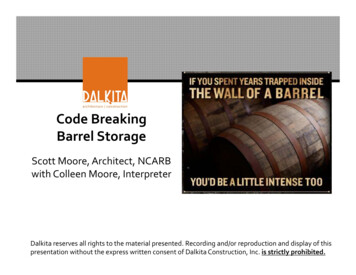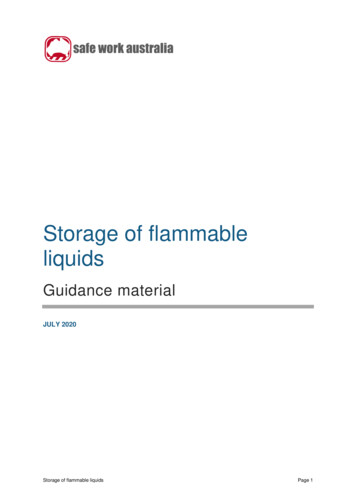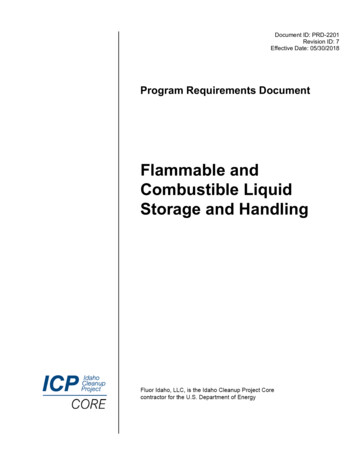
Transcription
Document ID: PRD-2201Revision ID: 7Effective Date: 05/30/2018Program Requirements DocumentFlammable andCombustible LiquidStorage and Handling
Idaho Cleanup Project Core412.09 (01/05/2017 – Rev. 12)FLAMMABLE AND COMBUSTIBLE LIQUIDSTORAGE AND HANDLINGProgram RequirementsDocumentManual: Subcontractor Requirements*The current revision can be verified on EDMS.Subcontractors1.Identifier: PRD-2201Revision*: 7Page:1 of 7For Additional Info:Effective Date: 05/30/18http://EDMSChange Number: 358490PURPOSEThis document provides requirements for storage and handling of flammable andcombustible liquids. This document implements requirements from codes and standardsalong with contractor (see def.) requirements. Any applicable regulatory or contractorrequirements must be followed, with the most stringent requirement being met.This procedure implements the applicable requirements of DOE O 420.1C, “FacilitySafety,” 10 CFR 851, “Worker Safety and Health Program,” and PRD-199, “IdahoCleanup Project (ICP) Fire Protection Program.”2.SCOPE AND APPLICABILITYThis document applies to all subcontractors working at the INL who store or handleflammable or combustible liquids, as specified by their contract with contractor. Stricterrequirements may be imposed by subcontractors upon their employees or subtiercontractors. The requirements of this document must be followed by subcontractors;however, the means of implementation may vary as determined by the subcontractor.NOTE:3.Throughout this document references to Idaho Cleanup Project (ICP) isanalogous with Idaho Cleanup Project Core.REQUIREMENTS3.1General Requirements3.1.1Subcontractors shall safely store and handle flammable and combustibleliquids in accordance with 29 CFR 1926.152 and NFPA 30.3.1.2Only approved or listed equipment and procedures shall be used forstoring, transporting, and dispensing flammable and combustible liquids.3.1.3Personnel shall use proper techniques for the safe storage, handling,dispensing, and use of flammable and combustible liquids.3.1.4Subcontractors shall request assistance and recommendations for uniquehazard potentials from the contractor Point of Contact (POC; see def).3.1.5Storage areas and work activities that involve flammable or combustibleliquids shall be periodically inspected.
Idaho Cleanup Project Core412.09 (01/05/2017 – Rev. 12)FLAMMABLE AND COMBUSTIBLE LIQUIDSTORAGE AND HANDLING3.2Storage3.2.1Subcontractors shall safely store flammable and combustible liquids inaccordance with 29 CFR 1926.152 and NFPA 30.3.2.2Any flammable liquid storage cabinets that are purchased for use at theINL shall have doors that are well fitted, self-closing, equipped with alatch and be Underwriters Laboratories, Inc., (UL) listed or FactoryMutual (FM) approved.NOTE:3.2.33.3Identifier: PRD-2201Revision*: 7Page:2 of 7Existing flammable liquid storage cabinets do not need to bereplaced, however, they do need to be Underwriters Laboratories,Inc., (UL) listed or Factory Mutual (FM) approved and need to be ingood condition with latches and self-closing devices (if provided) inworking order.The contractor POC shall be notified of major changes in flammable andcombustible liquids storage including:3.2.3.1Adding new (not listed on the current inventory list) ordeleting existing flammable and combustible liquids fromthe inventory in a storage area.3.2.3.2Relocating storage areas or cabinets.3.2.4Good housekeeping shall be maintained in and around areas whereflammable and combustible liquids are used and stored.3.2.5Flammable or combustible liquids shall not be stored or used beyondtheir shelf life.3.2.6Appropriate training shall be provided to personnel who will use orhandle flammable or combustible liquids.3.2.7Cutting, welding, and other hot work shall be prohibited near designatedstorage areas for flammable and combustible liquid until a safetyevaluation of the proposed work area is made.3.2.8Flammable liquids shall not be used for cleaning.Servicing and Refueling Areas3.3.1Service and refueling areas shall be designed, installed, and maintainedin accordance with 29 CFR 1926.152(g) and NFPA 30.
Idaho Cleanup Project CoreFLAMMABLE AND COMBUSTIBLE LIQUIDSTORAGE AND HANDLING4.412.09 (01/05/2017 – Rev. 12)Identifier: PRD-2201Revision*: 7Page:3 of 7DEFINITIONSSee LST-275.REFERENCES5.1Source Documents29 CFR 1926.152, Flammable and Combustible LiquidsNFPA 30, Flammable and Combustible Liquids5.2Related RequirementsThe following documents may also contain requirements that apply to thisactivity:PRD-2101, Hazard Communication6.APPENDIXESAppendix A “Technical Requirements for the Storage and Use of Flammable andCombustible Liquids”
Idaho Cleanup Project Core412.09 (01/05/2017 – Rev. 12)FLAMMABLE AND COMBUSTIBLE LIQUIDSTORAGE AND HANDLINGIdentifier: PRD-2201Revision*: 7Page:4 of 7Appendix ATechnical Requirements for the Storage and Use ofFlammable and Combustible Liquids1.GENERAL SAFETY MEASURES1.12.3.NFPA 30 shall be the basic standard for flammable and combustible liquids. Eachsubcontractor shall have a system for control of storage and use of flammablesubstances to ensure compliance with this procedure. Definitions in this Appendixshall be as in NFPA 30.STORAGE REQUIREMENTS2.1Flammable or combustible liquids shall not be stored in unapproved areas of afacility.2.2All portable dispensing flammable liquid containers shall be FM/UL-approved,and be labeled to allow quick identification of the contents.2.3Flammable/combustible liquid storage cabinets shall not be used for storage ofmaterials other than flammable/combustible liquids.2.4Flammable liquid storage rooms designed in accordance with NFPA 30 and theInternational Building Code (IBC) are required when quantities of flammable orcombustible liquids in use, dispensing, or mixing operations exceeds thequantities allowed in control areas for use-open conditions per NFPA 30 and theIBC. These rooms shall be isolated from other facilities by either two-hour or onehour rated construction, or as required by the NFPA 30.STATIONARY ABOVE GROUND CONTAINERS (TANKS)3.1Level indication shall be accomplished by a method other than a standard sightglass or similar equipment subject to breakage.3.2Tanks shall be diked to hold 125% of the capacity of the largest tank plus20 minutes of fire water discharge with overflow to a safe location; outside wherepossible in accordance with the IBC.3.3Containers (tanks) that are automatically refilled shall be provided with a highlevel alarm, adequate ventilation, and an overflow pipe that discharges to a safelocation.3.4Storable tanks shall be installed in accordance with the requirements of NFPA 30,IBC, and applicable environmental regulations.Appendix A
Idaho Cleanup Project Core412.09 (01/05/2017 – Rev. 12)FLAMMABLE AND COMBUSTIBLE LIQUIDSTORAGE AND HANDLING4.3.5Service tanks, such as those used for servicing vehicles, fuel storage for buildingheating systems, fuel storage for internal combustion engines, and similar tanksthat are located closer than IBC special requirements to buildings shall be buriedor separated by a fire wall.3.6Above ground tanks may be used for bulk storage of flammable liquids where thesize of the tank is such that it is not feasible to bury the tank underground. Tanksof this size are normally used for a facility main storage tank that provides storagefor pumping to individual day tanks or bulk plants provided for filling tank trucks.Such tanks shall be constructed, located, diked, and protected with suitable foamfire fighting equipment in accordance with NFPA 30, NFPA 31, and NFPA 11.Pneumatic or gravity discharge should not be used.3.7Storage tank construction shall follow American Petroleum Institute API 650Guidelines.OUTDOOR STORAGE4.15.Identifier: PRD-2201Revision*: 7Page:5 of 7Outside storage shall be maintained an adequate distance from importantbuildings and/or structures. Quantities of 500 gal should be stored a minimum of50 ft from facilities. Quantities of 500 gal should be a minimum of 100 ft fromany facility. Fuel storage shall be per NFPA 30.GENERAL USE AND HANDLING OF FLAMMABLE ANDCOMBUSTIBLE LIQUIDS5.1Transferring liquid by means of pressurizing the container with air is prohibitedunless exempted by a facility Fire Protection Engineer.5.2When transferring Class I liquids in laboratories from containers of less than5-gallon capacity, the transfer shall be made in one of the following manners:5.35.2.1With the use of a laboratory hood, or5.2.2In an area provided with ventilation to prevent the accumulation of aflammable vapor/air mixture.When transferring Class I liquids in laboratories from containers of 5-galloncapacity or more, the transfer shall be made in one of the following manners:5.3.1From a separate area outside the building5.3.2In a separate, inside storage room that complies with the requirements ofNFPA 30 and/or 29 CFR 1910.106.Appendix A
Idaho Cleanup Project Core412.09 (01/05/2017 – Rev. 12)FLAMMABLE AND COMBUSTIBLE LIQUIDSTORAGE AND HANDLING6.Identifier: PRD-2201Revision*: 7Page:6 of 75.4When dispensing from drums, the drums shall be equipped with UnderwritersLaboratories, Inc., (UL) listed or Factory Mutual (FM) approved dispensingdevices.5.5When transferring Class 1 flammable liquids between conductive containers, thecontainers shall be bonded with a wire. The bonding wire or one of the containersshall be grounded in accordance with the 29 CFR 1910. Portable containers offive gallon capacity or less need not be bonded nor are flammable liquid cabinetsrequired to be bonded or grounded unless liquids are dispensed from the cabinet.5.6The loading, unloading, and onsite transportation of bulk quantities of flammableand combustible liquids shall be in accordance with NFPA 30 and NFPA 385.5.7When flammable liquids are to be used in unusual circumstances, a hazardevaluation shall be used to establish safe working conditions.5.8When the use of hand tools is required in areas where flammable gases or liquidsare present, such use shall be limited to approved, non-sparking tools.5.9Special attention shall be given to the additional provisions required to preventfire or explosion in accordance with the National Electrical Code 70, Article 500.VENTILATION6.1The following mechanical ventilation is required where Class I flammable liquidsare being transferred or dispensed (this does not apply to laboratory areas or thoseareas involving the infrequent transfer of incidental quantities of flammableliquids.):6.1.1The ventilation flow rate shall be 1 ft3/min/ft2 of floor area, but in nocase less than 150 ft3/min.6.1.2The intake and exhaust points shall be within 12 inches of the floor andpositioned at opposite sides or ends of the room.6.1.3A flow monitor or equivalent mechanism shall be provided so an audiblealarm will sound if the ventilation system fails.6.1.4Each facility shall maintain or have available adequate test equipmentcapable of determining the existence of flammable gases (or vapors) oftypes constituting actual or potential explosion hazards in the facility.6.1.5Where dispensing is being done in inside rooms, operations shall complywith NFPA 30.Appendix A
Idaho Cleanup Project Core412.09 (01/05/2017 – Rev. 12)FLAMMABLE AND COMBUSTIBLE LIQUIDSTORAGE AND HANDLING7.8.Identifier: PRD-2201Revision*: 7Page:7 of 7ELECTRICAL EQUIPMENT7.1All electrical equipment, wiring, and fixtures located or used in areas in whichflammable liquids are stored, used, or handled, shall be UL-approved and of atype, and installed in a manner, complying with requirements of the NationalElectrical Code Article 500 for such installations.7.2An electrical inspection, testing, and maintenance program shall be conducted at afrequency sufficient to ensure that ignition of flammable vapor or dust byelectrical causes will be minimized per NFPA 70 and NFPA 30.7.3See NFPA 70 for details of grounding requirements for portable tools andextension cords used in locations where flammable vapors may exist.7.4The subcontractor shall determine the appropriate hazard classification and shallreview plans for approval of electrical installations in flammable liquids, gases,and dust liberating areas.CONTROL OF IGNITION SOURCES8.1Precautions shall be taken to prevent the ignition of flammable vapors. Sources ofignition include, but are not limited to, open flame, smoking, cutting and welding,electrical and mechanical sparks, spontaneous ignition and radiant heat.8.2Cabinet storage shall be kept free of open containers of Class I liquids.8.3Combustible wastes shall be stored in closed, metal containers for periodicdisposal.8.4Smoking is prohibited in the following government owned or controlled areas:8.4.1All indoor rooms and offices8.4.2All government vehicles8.5Precautions shall be taken to prevent ignition sources when working aroundhazardous or toxic materials.8.6Welding, cutting, and similar spark producing operations shall not be permitted inflammable liquid areas unless a safe work permit has been issued.8.7Power operated industrial trucks used to move containers of Class I liquids shallbe maintained per NFPA 505, “Powered Industrial Trucks, Including TypeDesignations, Areas of Use, Maintenance, and Operations.”8.8Good housekeeping and vegetation abatement shall be practiced.Appendix A
2. STORAGE REQUIREMENTS 2.1 Flammable or combustible liquids shall not be stored in unapproved areas of a facility. 2.2 All portable dispensing flammable liquid containers shall be FM/UL-approved, and be labeled to allow quick identification of the contents. 2.3 Flammable/combustible liquid storage cabinets shall not be used for storage of
